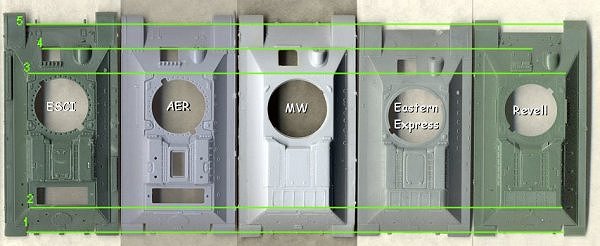| This is going to be
only a temporary article. Since I originally wrote my
T-34 Comparison article several years ago, there have
been some new T-34 kit releases in this scale, in
addition to me increasing my own knowledge of T-34
development. That article is in dire need of an update,
and in anticipation of such an update, several months ago
I had started an analysis of the various T-34 hulls
available to us. But I let the update effort lapse,
because of the announcement of UM's forthcoming T-34
kits. Since these kits are taking longer to arrive than I
anticipated, I decided to post the comparative scan of
the T-34 hulls that I had made with the currently
available plastic hulls. As I said, this will only be a
temporary article; once the UM kits hit the market, I
will add those kits into this analysis, and completely
revise the T-34 Comparison article. The scan below shows all of the currently available T-34 hulls in a side by side comparison (plastic hulls only). I lined up all the hulls at their rear hull line in order to compare their lengths. I drew in several lines on the scan to show how each hull differs from one another in certain dimensions. Click on the photo for a larger version of this scan. The lines are numbered as follows: 1. Rear hull. All kits are lined up on this line. This is the rear edge of the hull, and NOT the fenders. Fender length is variable between the kits. 2. Top of rear hull plate. I started this line from the left, with the ESCI kit. The other four kits pretty much line up with each other, but not with the ESCI kit. This is due to the flatter angle of the ESCI rear hull. 3. This line is the front of the upper hull (the top of the front armored plate). The ESCI, AER and MW kits line up with each other very well. The front hull plate on the Eastern Express kit is a little bit longer than the other kits, and it is on a slightly flatter angle. The front hull plate on the Revell kit is actually a little bit shorter than the others, but it is back further from this line, because the overall hull length is shorter than the others. 4. This line shows several things, such as how the driver's hatch and the machinegun mount line up with each other. For the three larger kits (ESCI, AER and MW), these items line up pretty well. The Eastern Express hull doesn't line up with any of them, because of the flatter and longer front hull plate. But even considering the longer front plate, it is obvious that the driver's hatch is mounted further up the hull than on the other kits. Notice how the Revell kit has much less plate in front of the driver's hatch. 5. The final line is the front edge of the hull. This is a good comparison of hull length, since it does not include the fenders. Again, the left three kits are all very close to one another. The Eastern Express kit is much shorter, and the Revell kit a little bit shorter yet. (Simon Barnes has reminded me that the Revell kit has an additional piece on the nose that adds a couple more mm, so it should be the same length as the EE kit, or perhaps a hair longer.) Based on the drawings I have seen, I feel that the Eastern Express and Revell hulls are more accurate in their length than the others, but note that I do not have access to the latest, accurate drawings included in several of the relatively new Russian modeling magazines. I recall a recent discussion on the Missing Lynx Braille Scale forum about the hull parts included in the MW T-34 kits. The hull in the scan above was taken from the NVA Type 63 AA Tank kit, and as you can see, it is a completely different piece than all the others. MW has three other T-34 kits (two recovery vehicles and a Flakpanzer), and I do not know what hulls are included in those kits. I would have assumed that it was the same one here, but I have read others say that they come with the Eastern Express hull. Since the chassis parts from these kits are the same as those in the Eastern Express kits, perhaps there is some variation of which hull parts are included; or perhaps those other reviewers simply assumed that since the chassis parts were the same as the EE, so to must be the hull. But that is obviously not the case here. |
